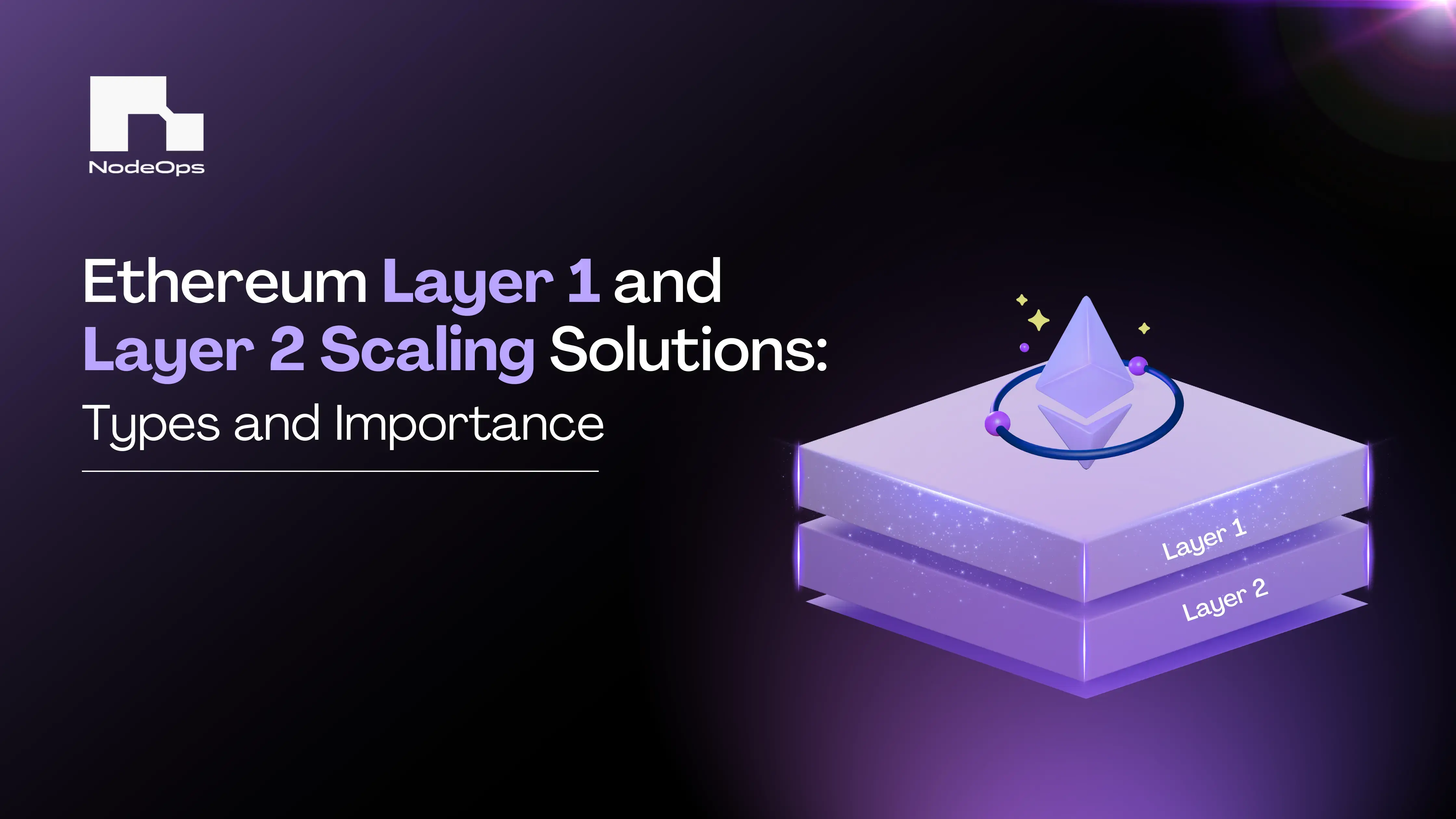Ethereum Layer 1 and Layer 2 Scaling Solutions: Types and Importance
 NodeOps
NodeOps
As crypto builders and users grow, they seek more efficient and robust blockchain solutions. They need systems that can handle more activity and work efficiently. Scalability is a critical factor driving the success and adoption of decentralized applications (dApps), decentralized finance (DeFi), blockchain, and Web3 networks. The market’s exponential growth has made it even more evident that the need for advanced scalability is high. This article will explain Ethereum's Layer 1 and Layer 2 scaling solutions. We'll cover what they are, their types, and importance.
What is Blockchain Scalability?
Blockchain scalability refers to the capacity of a blockchain network to handle an increasing number of transactions and users without adversely affecting its performance, security, or decentralization. With more users on a blockchain, the network can get crowded. This results in slower transactions, higher fees, and other security issues.
Before we talk about the scaling solutions, let’s take a quick look at the Ethereum network.
Source| Ethereum network and scaling solutions
Ethereum (ETH) was launched in 2015 as a decentralized network. As of today, it is the top platform for DeFi and NFTs. Ethereum’s architecture includes two primary layers; Layer 1 and Layer 2. Addressing scalability is crucial for sustaining blockchain technology, particularly in the case of Ethereum, where cross-layer communication and asset transfers are essential.
What is the Layer 1 Scaling Solution?
Layer 1 is the base protocol of the blockchain network, enhancing scalability, transaction speed, and processing capacity. In addition to Ethereum, Bitcoin and Cardano are popular Layer 1 blockchains. They handle the network’s integrity through a Proof-of-Work (PoW) or Proof-of-Stake (PoS) consensus mechanism. There are different ways to scale the Layer 1 blockchain:
Increased block size
Some Layer 1 blockchains, like Bitcoin Cash (BCH), have increased their transaction block sizes from 8MB to 32 MB, allowing them to process more than 100 transactions per second.
Updated consensus mechanism
In 2022, Ethereum transitioned from PoW to PoS mechanism and relies on stakers locking up ETH tokens to validate transactions. It uses a lottery system rather than the computational power of the PoW (like Bitcoin) to mine the next block.
Sharding
Sharding involves breaking the blockchain database into small segments, called shards, to process the network transactions simultaneously. Parallel data processing increases the overall capacity and efficiency of the Layer 1 blockchain.
The Need for Layer 2 Solutions
Despite Ethereum transitioning to PoS, the network is facing several scalability issues:
Ethereum’s Layer 1 processes 20 to 30 transactions per second (TPS).
The average gas fee is also high, making the network less accessible to users.
The blockchain scalability trilemma suggests that achieving scalability, security, and decentralization together is challenging.
Source|The blockchain trilemma
This is why Layer 2 scaling solutions are in high demand today. With Layer 2 solutions, we at NodeOps are trying to overcome these limitations without compromising on security, scalability, and user experience.
Layer 2 Scaling Solution and Its Types
Layer 2 scaling solutions are built on top of the blockchain’s main layer (Layer 1) to improve its scalability and efficiency. By handling more transaction load, Layer 2 reduces congestion on the main layer. Now, let us discuss the types of Layer 2 scaling solutions in detail.
Rollups
Rather than verifying each transaction, rollups bundle multiple transactions into a single batch, processing them off-chain before submitting them to the main blockchain network. This significantly increases transaction output while maintaining overall security. There are two types of rollups:
Optimistic rollups
They treat transactions as valid by default. This process involves two parties. One puts the rolled-up transaction on the mainnet, while the other sends fraud-proofs if it detects any invalid or malicious transactions.
Both parties stake tokens on the main network, which helps resolve any disputes that arise. However, the chances of invalid transactions are low in optimistic rollups due to their dual-validation system. OP Stack, Arbitrum Orbit, Base (by Coinbase), and Zora, are popular optimistic rollup platforms.
Zero-knowledge (ZK) rollups
ZK rollups rely on an advanced cryptographic tool called Zero-Knowledge proofs. They pack transactions with this cryptographic proof called SNARK (Succinct Non-Interactive Argument of Knowledge). The rollup is then undertaken and confirmed by a contract on the main Layer 1 blockchain. The setup demands proof for transactions on the main network to boost efficiency without needing any dispute resolution, as optimistic rollups. Polygon CDK, StarkNet, and zkSync Era are some leading examples.
Rollups-as-a-Service (RaaS)
Rollup-as-a-Service is a comprehensive platform that enables Web3 companies, decentralized application (dApp) projects, and developers to create and manage their own Rollup chains and AppRollups, similar to SaaS. It empowers developers to create scalable blockchain solutions without encountering any technical hurdles.
We are leading in such a tech revolution. Our collaboration with leading RaaS providers, such as Lumoz and Caldera, is enabling developers to focus on devising more innovative apps. Developers can benefit from this while relying on NodeOps’ single-click node deployment and operations expertise.
Side chains
These are independent blockchains that run adjacent to the main chain, each with its own validators in a large transaction batch. Side chains follow an independent consensus mechanism, different from the main one. The transactions are publicly recorded on the ledger, and any security breaches in the chain do not hinder the efficiency or integrity of the main chain or other side chains.
State channels
Similar to side chains, state channels are off-chain scaling solutions that enable faster and cost-efficient transactions by facilitating direct communication between parties without requiring validation from the main blockchain network. They use smart contracts or multi-signature mechanisms to create secure channels. Once transactions are completed off-chain, the “final state” (completed) is recorded on the main blockchain, improving overall scalability. Ethereum's Raiden Network, Liquid Network, Celer, and Bitcoin Lightning are some examples of state channels.
Importance of Scaling Solutions
Higher transaction output: scaling solutions enable blockchains to process more TPS compared to centralized systems.
Cost-efficient transactions: scalability increases efficiency and helps lower the transaction gas fees.
Growth of dApps: scalable blockchains can handle the increasing number of dApps, especially in the DeFi and gaming sectors.
Maintains decentralization: the scaling solutions enhance the overall performance without compromising the decentralized nature of the blockchain.
Enhances usability: quick transaction times and lower costs create a better user experience and drive increased market adoption of the technology.
Ethereum is currently working on more upgrades and innovations to address the challenges of both Layer 1 and Layer 2 scaling. As blockchain technology continuously evolves, advanced scaling solutions will become more prominent.
The Bottom Line on Ethereum’s Scaling Solutions
Ethereum’s Layer 1 and Layer 2 scaling solutions are crucial for the sustenance of the blockchain ecosystem. While Layer 1 offers a secure and decentralized foundation, Layer 2 provides scalability and cost reduction. By leveraging both these layers, developers and blockchain companies can easily explore the potential of blockchain scalability. These scaling solutions are designed to tackle high transaction fees and network congestion issues. Layer 2 solutions are gaining more acceptance due to their ability to address the blockchain trilemma.
NodeOps is a cutting-edge web3 infrastructure platform designed to simplify blockchain node deployment and management across multiple networks. Our mission is to empower developers and node operators with an intuitive, AI-driven set of tools and services that simplify the complexities of blockchain infrastructure. NodeOps caters to a wide range of blockchain protocols, including EigenLayer, Aethir, Celestia, XAI Games, Zora, Avail, Fuel, and various cosmos ecosystem-based L1s such as OraiChain & Archway. Thanks to its containerized on-demand infrastructure, NodeOps scales to fulfill the evolving demands of the blockchain ecosystem. We've raised over 125 million via our Node Sales, including CARV, Aethir, XAI, Lumoz, and more, and are currently supporting over 45 protocols with more than 37.1K+ nodes.
Join NodeOps today and try out one-click node deployment across our supported protocols. Further, for protocol updates, follow NodeOps on X!
Subscribe to my newsletter
Read articles from NodeOps directly inside your inbox. Subscribe to the newsletter, and don't miss out.
Written by

